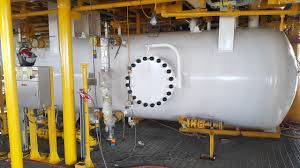API 510 Pressure Vessel Inspections
- Thorough inspection of pressure vessels requires the use of Non-destructive testing (NDT) measures, such as Ultrasonic-Testing, Dye Penetrant and Radiographic Testing. The inspection of a pressure vessel will be required prior to being placed into service, at the time of any major repair or alteration, as well as, at the external inspection interval of 5 years, and the internal inspection interval of 10 years. Certified inspectors trained to API 510 and technicians experienced in NDT are required to carry out these inspections to the American Petroleum 510 Standard.
Inspection Intervals
-
- Under the API 510 Standard, Internal Inspections are to take place at no more than a 10 year interval and are performed while the vessel is out of service, allowing for entry into the vessel. These inspections are the most informative because not only can NDT measurements be performed, but visual inspection of the internal walls and components of the vessel are highly revealing to its overall condition, specifically to welds, as well as, coating & lining systems. Because these inspections allow for the most detailed inspection, they are often the most time consuming and costly to carryout. Therefore, scheduling these inspections to take place when operation isn’t critical can provide great convenience and operational cost benefits for your facility. Further inspection intervals can be set through the use is Risk Based Inspection (RBI). We discuss RBI in greater depth below.
API 510 Inspectors:
To properly interpret the standard, carefully carryout inspections and provide industry related reports, our inspectors must meet certain knowledge and experience requirements to be able to apply to become an API 510 certified Inspector through the American Petroleum Institute. Once approved, they must pass proctored examinations to gain entry into the industry as a certified inspector, something we pride ourselves on and hold with great integrity. Recertification must take place every 3 years in order to stay up to date with the latest industry standards and practices.
What is a Pressure Vessel?
- Pressure vessels are cylindrical containers designed to store products such as liquids and gasses at pressures ranging from 15 PSI to 3,000 PSI. They’re considered to be critical points in many facilities operations and product storage, making their inspection a critical task; If a specific location or mechanism on the vessel fails, the results could be severe. These vessels are usually welded steel with spherical heads to better allow them to withstand and contain great pressures. Because these vessels are designed to withstand significant internal pressure, they are generally much thicker than a normal shop fabricated or field erected aboveground storage tank (AST), and are considered to be much more dangerous. Pressure vessels have maximum safe operating pressures that must be maintained through close monitoring, especially in climates where temperatures can drop below freezing, causing the vessel to be at risk of brittle fracture.
ASME Pressure Vessels & Boilers
API 510 Standard: Pressure Vessel Inspection
The API 510 standard addresses the in-service Inspection, Repair, Alteration, and Rerating activities for pressure vessels and the pressure relieving mechanisms attached to the vessel. This Code was developed specifically in accordance with the American Society Mechanical Engineers: Boiler and Pressure Vessel Code, however, it is a respected industry standard for many vessels across a wide array of jurisdictions, including Pressure Vessels built to an un-known standard.
API 510 Pressure Vessel Inspections: Protip
of c
Inspection Intervals can be developed through the use of Risk Based Inspections (RBI). These inspection intervals are customized to accommodate the specific inspection needs of the facility of consideration, mitigating expenses and down time.
API 510 Pressure Vessel Inspection: Risk Based Inspections
Y
Risk Based Inspection VS. Fixed Interval Based Inspection
- Both Fixed Interval and RBI Inspections utilize the same inspection techniques at the time of inspection, however, they differ in the frequency at which inspection must occur. Fixed Interval Inspections are based on the same Fixed interval as they’re classified per-API Standard. After each fixed interval inspection is performed, the interval is rescheduled at a point in the future to be no more than the calculated from the corrosion rate. These intervals must adhere to the parameters laid out in API 653 and the data collected from the inspection. However, RBI inspections allow the inspection frequency to be altered to fit a risk prioritized inspection schedule where more risk equates to a more frequent inspection schedule, while less risk equates to a less frequent inspection schedule.
Advantages of RBI:
- Risk based inspection (RBI) is determined by performing a risk based analysis. This empirical analysis allows the inspection interval to be set outside of the fixed interval of inspection determined by the API Standard. This means that the inspection schedules are now able to be developed around prioritizing high-risk components, mitigating the inspection of low risk components. Risk Based Inspection can be very cost effective, allowing for a more convenient inspection schedule to be built around a facility’s operation and processing pattern, while also reducing the probability of mechanical failures and equipment degradation. This is done by targeting higher risk variables for more frequent inspection, and lesser risk variables for less frequent inspection, saving money and time.


